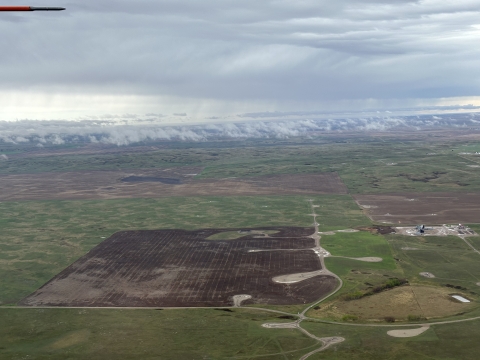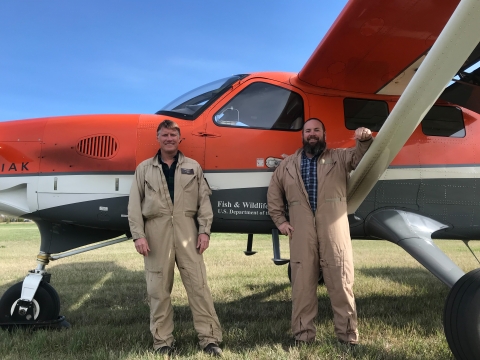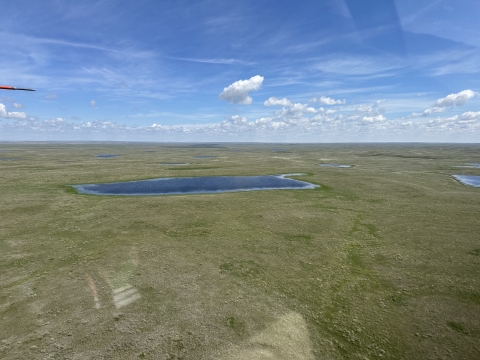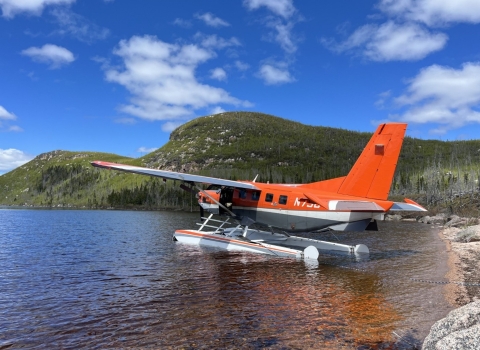The last day we surveyed for waterfowl in Montana ended like the previous four days, with bad weather, forcing us to end the survey earlier than planned. It was the wind this time. When the wind picks up above 25 mph, we hit the survey standard operating procedures (SOP) limit for wind speed. The reasoning behind this comes from how the wind affects the plane. A tailwind pushes the plane along the transect faster (25 mph faster), so the observers have less time to identify all the ducks below them. The SOP states that the survey should be flown between 90-105 mph, but if you have a 25 mph tailwind, that pushes the plane faster along the ground and up to or over the SOP upper speed limit.
Crosswinds also can become a problem at higher wind speeds. For example, if we have a 25 mph wind from the north and we are heading west, we have a crosswind. If I didn’t add a wind correction angle (i.e., turning the plane in the direction of the wind so I stay on the transect line) the plane would drift, in this case south and off the transect. By turning the plane to a new heading (adding a wind correction), the plane then stays on the transect, but we are actually flying on an angle to the transect. In this example, the plane is angled to the north and the pilot is looking at more of the transect through their side window instead of out the front window and the observer ends up looking back on the transect. All of that combined makes it much harder to identify ducks.
In rougher terrain, high winds can also create mechanical turbulence. Mechanical turbulence is like water in a river, when water flows over rocks near the surface, you get rapids. In an airplane, when you are low to the ground and in rough terrain, the wind blows across the terrain and forms “rapids” of air. The plane starts to bounce around in those “rapids” and starts to draw the pilot’s attention away from surveying and towards keeping the plane under control, which can also distract the observer from their job of counting ducks. This is why the SOP has wind speed limits:they are in place so the survey is consistent and gives the crew the best possible conditions for counting ducks.
For both the pilot and observer, it can be a hard decision to stop the survey as we are all mission driven. However, when you think of it as a duck survey and you feel like you aren’t doing a good job counting ducks, the decision becomes easier. After bumping along and flying sideways, I made the decision that we weren’t doing a good job anymore and needed to climb up and head to Regina, Saskatchewan.
We arrived in Regina, cleared customs, and visited with the airport regulars; some of whom I’ve known for over 20-years! We caught up on comings and goings and of course, the weather. We learned that it was a dry, mild winter.Not good news for the on-going drought in Saskatchewan. Little snow meant little run off into the wetlands that ducks use. Fewer ponds mean fewer ducks, less production, and fewer young ducks flying south from Saskatchewan. We decided to do some ground reconnaissance and check out what conditions looked like by car before we started the survey.
The drought started to break in Saskatchewan and rain and low ceilings continued off and on all month, extending the three-week survey by about eight days. The timing of the rains in early May was still beneficial to many ducks. Early nesting mallards and pintails would have time to re-nest if first nests were flooded out and species that start nesting later in the summer would have better wetland conditions and upland habitat for nesting and brood rearing. Many locals said they couldn’t remember the last time they saw the landscape so green. Timing of rain is usually better when it is received in April, before the bulk of the breeding waterfowl move into Saskatchewan and start nesting. However, in this case, given how dry the prairies of Canada were this year, any rain at all was well received.
The grasslands and Parklands of Saskatchewan were in a mixed state of extremely dry to recovering from drought. There are still areas that are dry with no available waterfowl breeding habitat, but a few good areas also exist. Overall, most of the southern Saskatchewan survey area had fair conditions for breeding waterfowl.












